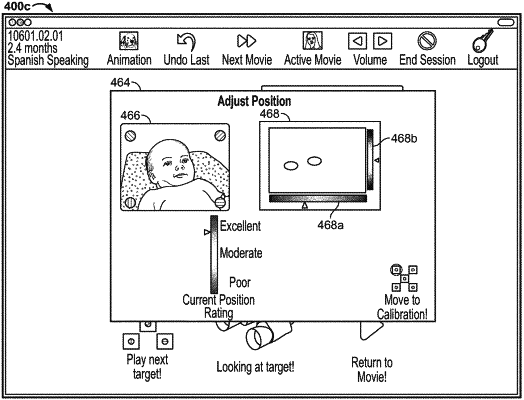| CPC A61B 3/113 (2013.01) [A61B 3/0025 (2013.01); A61B 5/163 (2017.08); A61B 5/167 (2013.01); A61B 5/168 (2013.01); A61B 2503/04 (2013.01); A61B 2503/06 (2013.01)] | 34 Claims |

|
1. An autism spectrum disorder (ASD) diagnosis system, comprising:
a patient device comprising a patient stimulus display screen configured to:
in response to a graphic user interface of a touchscreen device receiving user input for initiating a calibration of an eye tracker sensor relative to eyes of the patient:
present at least one fixation target on the patient stimulus display screen;
record eye tracking data during display of the at least one fixation target; and
identify fixation of the eyes of the patient during the display of the at least one fixation target; and
present a session of one or more stimulus movies to a patient;
the eye tracker sensor oriented to collect session eye tracking data of the patient during display of the session of the one or more stimulus movies;
an audio speaker configured to output audio for the one or more stimulus movies; and
the touchscreen device having the graphic user interface configured to:
receive an input of identification information associated with the patient;
initiate the calibration of the eye tracker sensor relative to the eyes of the patient; and
control playback of the one or more stimulus movies on the patient stimulus display screen of the patient device; and
a computer system configured to:
receive the session eye tracking data of the patient and a corresponding session list of the one or more stimulus movies presented to the patient; and
output a computer-generated ASD diagnostic report indicating a comparison of the session eye tracking data of the patient to prior session eye tracking data of the patient.
|